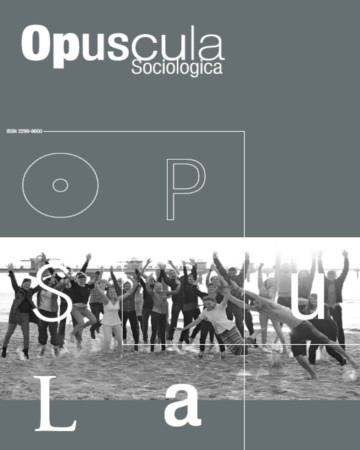
ISSN: 2299-9000
eISSN: 2353-2882
OAI
DOI: 10.18276/os.2018.1-03


Issue archive /
nr 1/2018
Dzietność jako element życia społecznego we współczesnym społeczeństwie polskim
(The Total Fertility Rate (TFR) as an Element of Social Life in the Present-Day Polish Society)
| Authors: |
Jakub
Isański

Uniwersytet im. Adama Mickiewicza w Poznaniu |
| Keywords: | TFR (total fertility rate) a decline in TFR life style present-day Polish society |
| Data publikacji całości: | 2018-11 |
| Page range: | 11 (25-35) |
Abstract
The purpose of the article is to present social contexts of TFR in the present-day Polish society. The recent years have seen a signifcant decline in the fertility rate, and the information on the subject matter in the all available literature induces to look for other explanations than the demographic ones. The article contains information on various spheres of social life, which reveals the scale and possible causes of the phenomenon of the decline in TFR, as well as the consequences of the decreasing number of children in social and economic life in Poland. Many other studies to be found in the literature show a wider global scale of that phenomenon, which provokes reflection and prompts a search for the explanation of the phenomenon.
Download file
Article file
Bibliography
| 1. | Alvare, H.M. (2017). „Cheap sex”: mapping the new mating market. Mercatornet. Pobrane z: https://www.mercatornet.com/mobile/view/cheap-sex-mapping-the-new-mating-market (1.03.2017). |
| 2. | Baskerville, S. (2009). Freedom and the Family: The Family Crisis and the Future of Western Civilization. Humanitas, XXII (1–2), 168–184. |
| 3. | Beck, U. (2002). Społeczeństwo ryzyka. W drodze do innej nowoczesności. Warszawa: Scholar. |
| 4. | CBOS (2017a). Osoby niezamężne i nieżonate w polskich rodzinach (oprac. R. Boguszewski, M. Piszczatowska-Oleksiewicz). Komunikat z badań CBOS 93. |
| 5. | CBOS (2017b). Plany prokreacyjne kobiet (oprac. M. Omyła-Rudzka). Komunikat z badań CBOS 117. Country Comparison: Total Fertility Rate (2017). Pobrano z: https://www.cia.gov/library/publications/resources/the-world factbook/rankorder/2127rank.html (1.03.2017). |
| 6. | Centrum im. Adama Smitha (2017). Koszty wychowania dzieci 2017. Pobrano z: http://smith.pl/sites/default/fles/zalaczniki_201706/r-17-dzieci-1-06-1f.pdf (1.03.2017). |
| 7. | Corselli-Nordblad, L., Gereoffy, A. (2015). Marriage and birth statistics – new ways of living together in the EU. Eurostat Statistics Explained. Pobrano z: http://ec.europa.eu/eurostat/statistics-explained/index.php/Marriage_and_birth_statistics_-_new_ways_of_living_together_in_the_EU (1.03.2017). |
| 8. | Cowan, R.S. (1976). The ”Industrial Revolution” in the Home: Household Technology and Social Change in the 20th Century. Technology and Culture, 17 (1), 1– 23. |
| 9. | Czapiński, J., Panek, T. (red.) (2015). Diagnoza społeczna 2015. Warunki i jakość życia Polaków. Warszawa: Rada Monitoringu Społecznego. |
| 10. | Dolińska, B. (2016). Bezdzietność. Perspektywa społeczno-kulturowa. Warszawa: Smak Słowa. |
| 11. | Golka, M. (2008). Socjologia kultury. Warszawa: Scholar.34 / jakub isański / dzietność jako element życia społecznego we współczesnym społeczeństwie polskim. |
| 12. | Gołata, E. (2016). Estimation of fertility in Poland and of Polish born women in the United Kingdom. Studia Demografczne, 1 (169), 13–38. |
| 13. | Giddens, A. (1992). The transformation of intimacy: Sexuality, Love and Eroticism in Modern Societies. Stanford: Stanford University Press. |
| 14. | GUS. (2017). Rocznik Statystyczny Rzeczypospolitej Polskiej. Główny Urząd Statystyczny. Pobrane z: rocznik_statystyczny_rzeczypospolitej_polskiej_2017.pdf (20.01.2018). |
| 15. | Isański, J. (2015). Migracje i transfery kapitału społecznego. Poznań: WN UAM. |
| 16. | Kotowska, I. (red.) (2014). Niska dzietność w Polsce w kontekście percepcji Polaków – diagnoza społeczna 2013. Piaseczno: Drukarnia Braci Grodzickich. |
| 17. | Lesthaeghe, R. (1980). On the Social Control of Human Reproduction. Population and Development Review, 6 (4), 527–548. |
| 18. | Lesthaeghe, R. (2014). The second demographic transition: A concise overview of its development. PNAS, 111 (51), 18112–18115. |
| 19. | Levitt, P, Lamba-Nieves, D. (2011). Social Remittances Revisited. Journal of Ethnic and Migration Studies, 37 (1), 1–22. |
| 20. | Michalski, M.A. (2014). Kulturowe sprzeczności państwa opiekuńczego i ich wpływ na człowieka, relacje międzypokoleniowe i struktury pośredniczące. W: M. Szczepański, M. Brzęczek, M. Gajowiak (red.), Systemy zabezpieczenia społecznego wobec wyzwań demografcznych i rynkowych (s. 1–15). Poznań: WN UAM. |
| 21. | Mynarska, M. (2014). Zamierzenia prokreacyjne Polaków i ich zróżnicowanie według cech demograficznych i ekonomicznych respondentów. W: I. Kotowska (red.), Niska dzietność w Polsce w kontekście percepcji Polaków – diagnoza społeczna 2013 (s. 52–60). Piaseczno: Drukarnia Braci Grodzickich. |
| 22. | Mynarska, M., Baranowska-Rataj, A., Matysiak, A. (2014). Free to stay, free to leave: Insights from Poland into the meaning of cohabitation. Demographic Research, 31, 1107–1136. |
| 23. | Przybył, I. (2017). Historie przedślubne. Poznań: WN UAM. |
| 24. | Putnam, R.D. (2008). Samotna gra w kręgle. Upadek i odrodzenie wspólnot lokalnych w Stanach Zjednoczonych. Warszawa: Wydawnictwo KR. |
| 25. | Regnerus, M. (2017). Cheap Sex: The Transformation of Man, Marriage, and Monogamy. Oxford: Oxford University Press. |
| 26. | Riesman, D., Glazer, N., Denney, R. (1996). Samotny tłum. Warszawa: Muza. |
| 27. | Rogalińska, D., Szałtys, D. (red.) (2017). Atlas demograficzny Polski. Główny Urząd Statystyczny, Departament Badań Demograficznych i Rynku Pracy, Departament Badań Regionalnych i Środowiska, Urząd Statystyczny w Olsztynie, Warszawa: Druk Zakładu Wydawnictw Statystycznych. |
| 28. | Schmidt, F. (2015). Para, mieszkanie, małżeństwo. Dynamika związków intymnych na tle przemian historycznych i współczesnych dyskusji o procesie indywidualizacji. Warszawa–Toruń: WN UMK. |
| 29. | Schulz, N. (2013). Home economics. The consequences of changing family structure. Washington: American Enterprise Institute Press. |
| 30. | Stańczak, J., Stelmach, K., Urbanowicz, M. (2016). Małżeństwa oraz dzietność w Polsce. Główny Urząd Statystyczny, Departament Badań Demograficznych i Rynku Pracy. |
| 31. | Szpunar, M. (2016). Kultura cyfrowego narcyzmu. Kraków: Wydawnictwo AGH. |
| 32. | United Nations, Department of Economic and Social Affairs, Population Division (2013). World Population Prospects: The 2012 Revision. Pobrano z: https://esa.un.org/unpd/wpp/ (1.03.2017). |
| 33. | Ziółkowski, M. (2000). Przemiany interesów i wartości społeczeństwa polskiego. Teorie, tendencje, interpretacje. Poznań: Humaniora. |